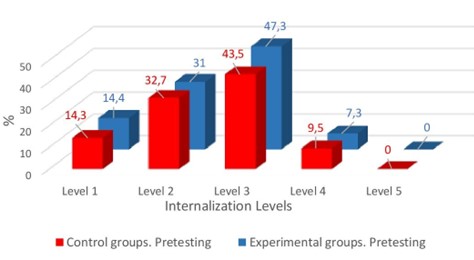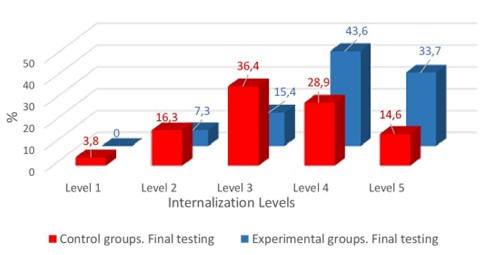СТУДЕНТ КАК СУБЪЕКТ ОБРАЗОВАТЕЛЬНОЙ ДЕЯТЕЛЬНОСТИ НА УРОКАХ АНГЛИЙСКОГО ЯЗЫКА
СТУДЕНТ КАК СУБЪЕКТ ОБРАЗОВАТЕЛЬНОЙ ДЕЯТЕЛЬНОСТИ НА УРОКАХ АНГЛИЙСКОГО ЯЗЫКА
Аннотация
В статье говорится о том, что психологические данные имеют большое значение при овладении иностранным языком, т. к. сам предмет - иностранный язык - является отражением мыслительной деятельности. Использование культурно-исторической теории подтверждает, что диалектическое единство мышления и говорения позволяет проявляться интропсихологическим аспектам через такие речевые действия, как учебный диалог и ролевая игра. Повышение уровня интериоризации на занятиях по иностранному языку подтверждает мысль и иллюстрирует социальное развитие ученика при сотрудничестве с учителем. Эта проблема решается с помощью высокого уровня взаимодействия на занятиях и реального опыта ученика, проявляемого через активность с перспективой развития личности.
1. Introduction
The subject of this article touches upon an important issue of mediating human development through language and culture. Transformation from interindividual relationship of a person and environment to intraindividual acts of self-government practically proofs the transition of the external forms of action to the interior ones, that leads to the formation of intellectual assets. Special attention should be drawn to language, cognition, communities and semiotic mediation. The grammatical learning is achieved as a consequence of their interactions, which is evidenced, among other things, by shifts from other-regulated to self-regulated error correction. The positive effects of learners verbalizing strategies by N.F. Talyzina [1] were extended to language learning. The communicative language teaching which is relevant to activity theory can give rise to similar outcomes [4] in an English as a Second Language class.
The main idea is to estimate classroom interactions and the foreign language acquisition in class, which allows relating human mental functioning to the cultural, institutional, and historical settings [5].
2. Methods
The study is based on three important aspects of the sociocultural view: the verbalization of the actions, semiotic mediation and theory of activity [2]. Much attention is given to a dialogue with others and with oneself (the so-called egocentric speech), which leads to interiorization, that is, the movement of this dialogue inside.
Actual and potential levels of development are a practical continuation of intra and interpsychological plans of mental activity within the framework of cultural development presented by M. Cole [6, P. 89]. We have a try to solve the difficulties of cooperative learning activity through a discursive cooperative revival of reality or “game” by M. Bakhtin [3], joint construction of the learning and development scheme by M. Donato [7], as well as through collaborative dialogue and the process of knowledge acquisition mediation.
All these aspects shift the concept of learning from the so-called training to the concept of participation [1]. It is clear that learning itself is a form of internalized social activity. The following Table 1 illustrates the obtained results.
Table 1 - Levels of internalization from interpsychological to intrapsychological language acquisition
Levels of knowledge | Explanation of the language behavior in practice |
Level 1 | The student cannot notice or correct the error, even with the help on the part of his/her teacher. |
Level 2 | The student can notice an error, but cannot fix it, even with someone else's help. |
Level 3 | The student can notice and correct the error, but only with the help of someone. He/she understands the clues and can use them in correcting errors. |
Level 4 | The student notices and corrects errors with a minimal prompt, or without it at all, and begins to assume full responsibility for correcting errors. But, nevertheless, the key phrases are not yet fully internalized, and so the student often makes mistakes. The student can even refuse from help. |
Level 5 | The student becomes more consistent in using key phrases in all contexts. The student is fully responsible for his/her mistakes and can correct them without any help. |
The student will be able to find the optimal embodiment of their desires and opportunities as a result of interiorization and exteriorization processes, that open up opportunities for independent and responsible actions [8]. The model was used with the Experimental Group students. The Control Group students were not specially motivated by a teacher to show in class “participation”.
3. Results
At the beginning of the studying course, the tool task for estimating the level of internalization was a linguistically unlimited task with no explicit grammatical task. “Free talk” technique was being practiced. Each pair of students was tasked with discussing the ways of doing their work, its benefits and drawbacks. The students in this study were tested individually. Firstly, they were asked a series of individual questions in the form of interviews, and secondly, they were asked three discussion questions, responding to which students had to express their opinion, tell the story and come up with a statement. The questions were formulated in such a way that, when answering, the need for compiling complex sentences with special vocabulary was arising. The correctness of their use was monitored and evaluated. The evaluation was carried out in three stages: ascertaining, control and post experimental ones. The last stage was held four weeks after the second. The data obtained were counted as four separate tests: the first 40 individual questions as one test, and each of the discussion questions as three separate tests. An initial analysis was conducted to determine whether the significant improvements in the use of specific language forms and personal activity had been obtained.

Figure 1 - The ascertaining stage of internalized social activity
The received data show that both groups possess alike abilities and skills. Overcoming the dichotomy between the individual and the social in language acquisition studies helps to investigate the dynamics of classroom foreign language acquisition. Thus, the authors try to unravel the difficulties of instructional interactions in a classroom [5]. It provides new psychophysiological items, which arise a student’s initiative in learning and real communication [9].
Two aspects of learning activity, such as cognitive activity and the applied results can be tracked with a classroom dialogue, i.e., mediating via cooperation of a teacher and a student, and students themselves. Such attitude helps students to become a subject of educational activity in the formation of the subject - subject relations.
The diagram in Figure 2 presents the development of interpersonal relations ending in internalization growth.

Figure 2 - Internalization growth from interpsychological to intrapsychological level of a foreign language mastering
4. Discussion
Language acquisition is another example of a social source of development with a close relationship between supporting student-teacher mutual attention and vocabulary enrichment. The level of knowledge gained under the circumstances depends on the ability to adjust the goals and objectives in class independently. Discussion of their actions in dialogues, correction of mistakes and collective explanation determined the accelerated process of internalization in the formation of new skills. The ability to carry out an objective action with the help of verbal expression does not imply the ability to notice and correct their own mistakes as in the initial stages, but to create a verbal statement. According to the theory of development by L. S. Vygotsky [10], we defined the third level of internalization (43,5% and 47,3%) at the ascertaining stage. It means that students need external assistance to determine the error. The extra growth of Experimental Group students at the 4th and the 5th levels during the final testing proves the proposed methodology.
Table 2 - Measurement Odds of Proficiency Internalization
Groups | Levels of internalization, % | |||||
First level | Second level | Third level | Forth level | Fifth level | ||
Control Groups | Measurement odds | -10,5 | -16,4 | -7,1 | +19,4 | +14,6 |
Experimental Groups | -14,4 | -23,7 | -30,9 | +36,3 | +33,7 | |
So, quantitative and qualitative analysis of the results confirmed that education is something more than the saturation of students’ memory with discrete information. The established model of communication replaces the diversity of mutual learning relationships of people with the statement of the boundaries of knowledge and ignorance, a rigid distinction between the functions of the sender (subject) and the recipient of information (object).
5. Conclusion
At the initial stage, the student works with models, and it draws attention to the described phenomenon. Further, with the development of the semiotic function, the ability serves as an instrument of thought transmission. The signified in the text becomes available to highlight the subject and meaning in the next step. The final stage is characterized by work with the form and content in the signifying context. In other words, students are taking part in a collaborative dialogue. Communicative collaboration is based upon the active and purposeful agent on the part of a student. Observations clearly show how the interaction in the zone of proximal development changes with some time (in this case in the course of two months) and is used as an instrument of mediation, which results in producing new psychophysiological items.
